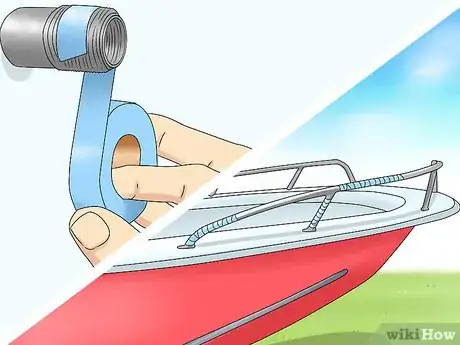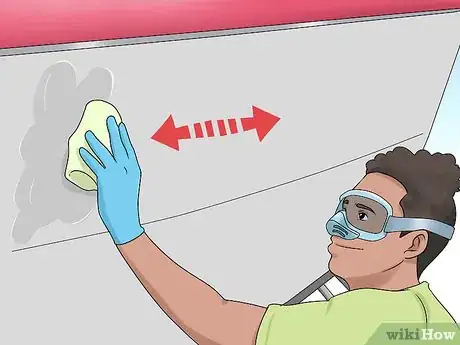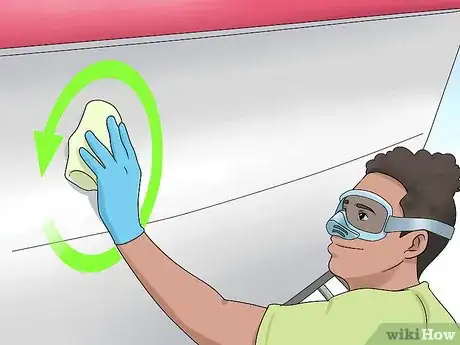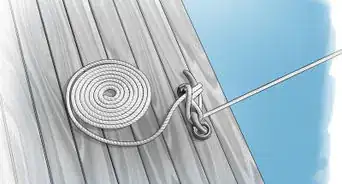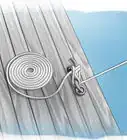This article was co-authored by Travis Lund. Travis Lund is the General Manager at the Vallejo Marina, a large marina located between the San Francisco Bay and the Delta in California. Sailing since he was six-years-old, Travis has over 15 years working in sailing operations and instruction and has pioneered a coaching platform that combined traditional coaching with multi-camera video support. He studied English at Michigan State University, where he was on the sailing team.
This article has been viewed 55,122 times.
Over time and with use, the gelcoat on your boat can become dull, making your boat look old. Restoring your gelcoat can help restore the shine of your boat and protect its surface. Begin by making sure any surface dirt and stains are removed. If your gelcoat is looking really dull, with no bright or shiny spots, you'll need to apply polish first. Once you've applied the polish, or if your boat isn't overly dull, you can move on to using wax.
Steps
Cleaning Your Boat
-
1Clean your boat's surface with boat soap and warm water. Boat soap is designed to reduce residue and is better for the environment than dish soap, so it's your best bet for cleaning your boat. Mix together 2 parts warm water with 1 part boat soap in a large pail or bucket. Dip a mop into the soapy mixture and then mop along the surfaces of your boat. You should see dirt come up as you mop.
- You can find boat soap at most home improvement and boat supply stores.
- You can use non-skid cleaners to clean the deck of the boat where the plastic is molded in and hard to clean.[1]
-
2Check for damage or cracks. Once your boat is clean, walk along it, looking for cracks. It can be helpful to run your hand over the surface of your boat as you walk, since you might feel a crack before you see it.[2]
- If you find small, hairline cracks in your boat, you can repair it yourself by using epoxy. Fiberglass epoxy is available at most boat supply stores. Follow the instructions on the epoxy for repairing the cracks.
- If the crack is deep or larger than a hairline crack, you'll need to take your boat to a professional to have it restored.
Advertisement -
3Use acid-based stain removers to remove mineral and organic stains. A gel acid-based stain remover will work best to remove stubborn stains. Wear rubber gloves and eye protection before you apply the remover. Use a rag to swab the cleaner across the stain and then let it sit for 20 minutes. Use a hose to rinse off the remover.[3]
- Depending on how bad the stain is, you may need to apply more than 1 coat.
- If you find that one type of stain is resistant to the remover, look for a specialty remover. You might need one to remove mold, black streaks, or rust.
-
4Tape off any fittings that could be damaged. Your boat likely has a lot of items that can't be removed, like metal fittings and railings. Use painters' tape to tape these areas off. It will protect them from getting scratched when you restore the gelcoat.[4]
Using Polish to Restore Shine
-
1Pour a small amount of polish onto a soft cloth. Most boat supply stores carry gelcoat polish. The label on the polish you choose should tell you exactly how much to use. However, you don't want to use too much, since you'll be working in small sections, no bigger than 1 ft (0.30 m) square.[5]
-
2Rub the polish into the gelcoat. Hold the cloth with the polish on it in your dominant hand. Then use small circular motions to rub the polish into the gelcoat. Continue rubbing until the surface gets a glassy shine.[6]
-
3Move along the hull horizontally. As you finish polishing each section, move to the same size section directly next to the section you just finished. Repeat the process for applying the polish all along the hull. Then drop down to just below your last section and begin moving in the opposite direction.[7]
Applying Wax to Restore the Gelcoat
-
1Wear protective gear. The chemicals in wax can have a strong odor and getting any in your eyes can cause serious damage. You should wear safety glasses and gloves before you begin applying the wax.[8]
-
2Pour some wax onto a soft cloth or foam pad. How much wax you should use will depend on the type of wax you're using. Check the container to see exactly how much you should pour onto your cloth or foam pad.[9]
- The best wax to use for restoring your gelcoat is marine wax. It's specifically designed for use on boats and it's waterproof. You can also use car wax, as long as it's hard shell wax.
- Use a cloth if you're applying the wax by hand.
- Use a foam pad if you're applying the wax with a buffer.
-
3Use a cloth to apply the wax by hand. Hold the cloth in the palm of your hand. Starting at one end of the hull, press the cloth against the hull of the boat and rub in the wax using a circular motion. You can move clockwise or counterclockwise, but stick to one direction. Otherwise you'll wipe it off![10]
-
4Use a buffer for large jobs. If your boat is large, or if you just don't have the time or patience to apply wax by hand, you can use a buffer. The foam pad will latch onto the buffer. Then place the pad flat against the hull of the boat and turn it on. The pad will automatically move in a circular motion, but you should also move the entire buffer in large, slow circles as you move along the boat.[11]
- Reload the pad with wax every few feet.
-
5Let the wax dry. Once the wax is mostly dry, it will form a hazy finish. Once you see this haze, use a soft old bath towel to buff away the excess wax. What's left over will fill the pits in the gelcoat and restore the shine.[12]
-
6Move along the boat in sections. Once you finish one area, move to the next section immediately next to it. Continue moving along the hull in a horizontal line. Once you've reached the end of the hull, move to below your last section of wax and begin working in the opposite direction back down the hull.[13]
-
7Repeat the waxing if your boat still looks dull. Depending on how long it's been since you last restored the gelcoat, you might need another layer of wax. If you do, you'll need to apply the wax by hand to prevent the first layer of wax from being taken off by a buffer.[14]
Expert Q&A
Did you know you can get expert answers for this article?
Unlock expert answers by supporting wikiHow
-
QuestionHow do I restore the gel coat on my boat?
 Travis LundTravis Lund is the General Manager at the Vallejo Marina, a large marina located between the San Francisco Bay and the Delta in California. Sailing since he was six-years-old, Travis has over 15 years working in sailing operations and instruction and has pioneered a coaching platform that combined traditional coaching with multi-camera video support. He studied English at Michigan State University, where he was on the sailing team.
Travis LundTravis Lund is the General Manager at the Vallejo Marina, a large marina located between the San Francisco Bay and the Delta in California. Sailing since he was six-years-old, Travis has over 15 years working in sailing operations and instruction and has pioneered a coaching platform that combined traditional coaching with multi-camera video support. He studied English at Michigan State University, where he was on the sailing team.
Sailing Instructor & Executive Director, Treasure Island Sailing Center
References
- ↑ https://www.westmarine.com/WestAdvisor/Gelcoat-Care-and-Restoration
- ↑ https://www.westmarine.com/WestAdvisor/Gelcoat-Care-and-Restoration
- ↑ https://www.westmarine.com/WestAdvisor/Gelcoat-Care-and-Restoration
- ↑ http://www.boats.com/how-to/how-to-restore-faded-gel-coat-on-a-boat/#.WoXJGGbMy3U
- ↑ http://www.boatus.com/boattech/casey/restore-shine-to-fiberglass.asp
- ↑ http://www.boatus.com/boattech/casey/restore-shine-to-fiberglass.asp
- ↑ https://www.westmarine.com/WestAdvisor/Gelcoat-Care-and-Restoration
- ↑ http://www.boatus.com/boattech/casey/restore-shine-to-fiberglass.asp
- ↑ http://www.boatus.com/boattech/casey/restore-shine-to-fiberglass.asp
- ↑ http://www.boatus.com/boattech/casey/restore-shine-to-fiberglass.asp
- ↑ http://www.boatus.com/boattech/casey/restore-shine-to-fiberglass.asp
- ↑ http://www.boatus.com/boattech/casey/restore-shine-to-fiberglass.asp
- ↑ https://www.westmarine.com/WestAdvisor/Gelcoat-Care-and-Restoration
- ↑ http://www.boats.com/how-to/how-to-restore-faded-gel-coat-on-a-boat/#.Wob3w2bMy3U



